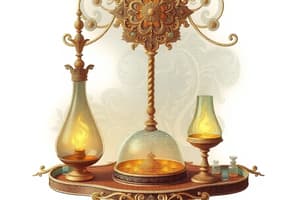Podcast
Questions and Answers
What is the significance of correctly balanced chemical equations in stoichiometry?
What is the significance of correctly balanced chemical equations in stoichiometry?
- They provide the amount of energy released in a reaction.
- They determine the color change in indicators during reactions.
- They define the state of matter of the reactants and products.
- They allow for accurate relationships between quantities of substances. (correct)
Which formula is used to calculate the density of a gas?
Which formula is used to calculate the density of a gas?
- Density = (Molar Mass * Temperature) / (Pressure * Ideal Gas Constant)
- Density = (Ideal Gas Constant * Temperature) / (Molar Mass * Pressure)
- Density = (Molar Mass * Pressure) / (Ideal Gas Constant * Temperature) (correct)
- Density = (Pressure * Temperature) / (Molar Mass * Ideal Gas Constant)
In gas stoichiometry, how can gas quantities be determined?
In gas stoichiometry, how can gas quantities be determined?
- Using the average kinetic energy of the molecules in the gas.
- From the total mass of reactants before the reaction occurs.
- By using balanced equations and their molar ratios. (correct)
- Applying the ideal gas law only when temperature is variable.
What happens to the volume of gas collected over water during a reaction?
What happens to the volume of gas collected over water during a reaction?
Which statement accurately reflects the ideal gas law?
Which statement accurately reflects the ideal gas law?
Which gas law describes the inverse relationship between pressure and volume of a gas?
Which gas law describes the inverse relationship between pressure and volume of a gas?
What is a key factor necessary for applying Charles's Law?
What is a key factor necessary for applying Charles's Law?
In the Ideal Gas Law equation, what does the 'R' represent?
In the Ideal Gas Law equation, what does the 'R' represent?
What does Dalton's Law of Partial Pressures state regarding a mixture of gases?
What does Dalton's Law of Partial Pressures state regarding a mixture of gases?
Which step is NOT part of the process for balancing chemical equations?
Which step is NOT part of the process for balancing chemical equations?
What is the significance of using Kelvin in gas laws?
What is the significance of using Kelvin in gas laws?
What is the relationship described by the Combined Gas Law?
What is the relationship described by the Combined Gas Law?
In balancing chemical equations, what should be done if coefficients result in fractions?
In balancing chemical equations, what should be done if coefficients result in fractions?
Flashcards
Mole of gas
Mole of gas
The amount of a substance that contains 6.022 x 10^23 particles (atoms, molecules, or ions).
Molar mass of gas
Molar mass of gas
The mass of one mole of a gas, usually expressed in grams per mole (g/mol).
Ideal Gas Law
Ideal Gas Law
A principle that relates the pressure, volume, temperature, and number of moles of a gas.
Gas density
Gas density
Signup and view all the flashcards
Gas stoichiometry
Gas stoichiometry
Signup and view all the flashcards
Boyle's Law
Boyle's Law
Signup and view all the flashcards
Charles's Law
Charles's Law
Signup and view all the flashcards
Gay-Lussac's Law
Gay-Lussac's Law
Signup and view all the flashcards
Combined Gas Law
Combined Gas Law
Signup and view all the flashcards
Dalton's Law of Partial Pressures
Dalton's Law of Partial Pressures
Signup and view all the flashcards
Avogadro's Law
Avogadro's Law
Signup and view all the flashcards
Conservation of Mass
Conservation of Mass
Signup and view all the flashcards
Study Notes
Gas Laws
-
Boyle's Law: Describes the inverse relationship between pressure and volume of a gas at constant temperature. Mathematically, P₁V₁ = P₂V₂. If pressure increases, volume decreases (and vice versa).
-
Charles's Law: Relates the volume of a gas to its absolute temperature at constant pressure. Mathematically, V₁/T₁ = V₂/T₂. As temperature increases, volume increases (and vice versa). Temperature must be in Kelvin.
-
Gay-Lussac's Law: Demonstrates the direct relationship between pressure and absolute temperature of a gas at constant volume. Mathematically, P₁/T₁ = P₂/T₂. As temperature increases, pressure increases (and vice versa). Temperature is in Kelvin.
-
Combined Gas Law: Combines Boyle's, Charles's, and Gay-Lussac's laws, allowing calculations involving pressure, volume, and temperature changes. Mathematically describes the relationship (P₁V₁/T₁) = (P₂V₂/T₂). Temperature in Kelvin.
-
Ideal Gas Law: A more general equation considering pressure, volume, temperature, and number of moles of gas. The ideal gas equation is PV=nRT, where P is pressure, V is volume, n is the number of moles, R is the ideal gas constant, and T is the temperature in Kelvin. Assumes gases behave ideally, meaning no intermolecular forces and negligible molecular volume compared to container volume.
-
Dalton's Law of Partial Pressures: The total pressure of a mixture of gases equals the sum of the partial pressures of each individual gas. Mathematically, Ptotal = P1 + P2 + P3... Applicable to mixtures of non-reacting gases.
-
Avogadro's Law: Equal volumes of gases at the same temperature and pressure contain equal numbers of molecules. One mole of any gas at STP occupies approximately 22.4 liters. Equal volumes imply equimolar amounts.
Balancing Chemical Equations
-
Conservation of Mass: The total mass of reactants must equal the total mass of products in a chemical reaction. Crucial for balancing equations.
-
Steps to Balance:
- Identify reactants and products.
- Write the unbalanced equation (symbols and formulas).
- Choose one element (ideal if in one reactant and one product), and add coefficients to balance it, often H, O, or a non-metal first.
- Repeat for other elements.
- If fractions result, multiply all coefficients by the lowest common denominator to get whole numbers.
-
Example: 2H₂ + O₂ → 2H₂O (H and O balanced)
-
Significance: Correctly balanced equations are essential for accurate stoichiometric calculations, which involve relationships between quantities of substances in a chemical reaction.
Gas Math
-
Moles of Gas: The number of moles (n) of a gas can be calculated using the ideal gas law if pressure (P), volume (V), and temperature (T) are known. Rearrange the Ideal Gas equation (PV = nRT) to solve for n.
-
Gas Density: Calculated using the formula Density = (Molar Mass * Pressure) / (Ideal Gas Constant * Temperature).
-
Gas Stoichiometry: Using balanced equations and molar ratios, gas quantities can be determined if the reaction involves gases.
-
Volume Relationships: Gas volumes in reactions can be predicted if their pressure and temperature are constant. Calculate volumes of gases involved in a reaction at constant temperature and pressure by using the balanced equation ratios.
-
Gas Collection Over Water: The collected gas volume includes water vapor, so subtract the partial pressure of water vapor at the reaction temperature from the total pressure to get the pressure of the collected gas.
Studying That Suits You
Use AI to generate personalized quizzes and flashcards to suit your learning preferences.




